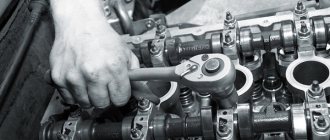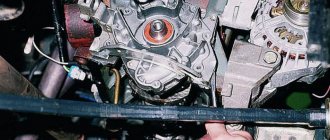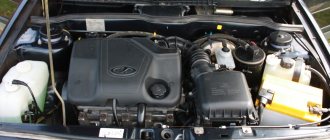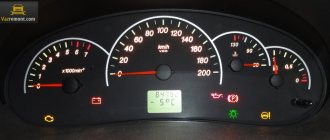There is one of the indicators on the dashboard of cars that informs the driver about a decrease in oil pressure in the engine unit. The so-called oil pressure light in the form of an oil can signals a critical condition of the engine - insufficient amount of lubricant. On the panels of VAZ “classic” cars (six, seven, nine) there is also such an indicator. And if it suddenly lights up while driving or at low speeds while parked, this is a signal that there is a malfunction in the engine.
Why does the oil pressure light come on in a VAZ classic?
The first step is to distinguish cases when an icon in the form of an oil can is suddenly displayed. It is completely safe for the icon to light up for just a few moments in the following cases:
- when there is a strong roll of the car on a sharp turn;
- when starting in winter;
- after a long period of parking on uneven ground.
As a rule, in such situations, oil flows from one part of the engine to another, which is why the oil pressure sensor is triggered. However, after some time, the working fluid is evenly distributed, and the signal about a drop in pressure in the system stops. The situation is similar when starting the engine unit in the cold season: at low temperatures, the working fluid thickens, accordingly, it is necessary to warm up the engine properly in order to create the necessary pressure in the system.
In all other cases, the appearance of an oil can on the instrument panel indicates the presence of failures or malfunctions. So for what reasons can the oil pressure light come on in classic VAZ models?
- First of all, due to a lack of oil in the engine.
- Due to an exhausted oil filter.
- The oil pressure sensor or its wiring is to blame.
- Wear of the liner on the crankshaft.
- The oil pump has failed.
Any of these reasons can affect the oil pressure level in the engine unit. Therefore, the car owner will first have to find the source of the problem and only then begin troubleshooting.
The oil level control device is located separately
This is interesting: How to increase engine power - truly effective ways
Causes
If you don’t trust the oil pressure sensor, or it’s a glitch in the instrument panel, you can measure the pressure yourself. All you need is a tool. Or auto service!
There may be several reasons for the malfunction and here are the most basic of them.
Oil level
The root cause of such a malfunction may be a simple lack of oil in the engine. If its level drops below normal, it must be topped up and this indicator checked. If the light went out, that was the reason. Don't forget to change and refill it on time.
Engine oil level is minimal
If the problem appeared after replacing the old oil with a new one and the problem did not disappear after 20 seconds after starting, then the reason lies in a non-working fuel filter, or the oil viscosity does not meet the manufacturer’s recommendations.
Oil pressure sensor
Another reason that may be observed is the oil pressure indicator. You can check its functionality by visual inspection or by shorting the ground wire to the engine. Do not rush to replace the oil pressure sensor with a new one, since the cause of the malfunction of the old one may be contamination of the channels. If the circuit is working properly, connect a working, new or cleaned sensor to the system in advance and connect the power. The lamp continues to light, which means you need to read below.
Old and new oil pressure sensor
Wiring
Broken wiring in the fuse box
The pressure sensor can not only short to ground, but also give incorrect results due to a broken wiring.
Diagnosis can be made by manually checking the oil pressure. The method is in the picture at the very beginning of the article.
Oil pump
To dismantle the oil pump, you will need to drain the engine oil and unscrew the engine crankcase. Then remove the oil pump and inspect it for damage. Most often, the cause of failure is the pressure reducing valve, which “sticks” on the housing during operation. The problem can be solved by lubricating it or replacing it with a new one.
New oil pump
How does the oil sensor work and why can it fail?
Now let's consider the situation if you are on the road and the low pressure indicator has triggered.
The very first thing you need to do is stop the vehicle and turn off the engine. As soon as it cools down, you will have to check the lubricant level in the system. There is a special dipstick under the hood for this purpose. It is wiped dry and immersed in its original place. It is quite possible that the level will be below the minimum level. This means that somewhere there is a leak or depressurization of connections. You can set off again only after adding oil to the engine. If the lamp continues to light after starting and does not go out subsequently, it makes sense to think about towing the car to the nearest service station or to a trusted auto mechanic. The matter may turn out to be quite serious, so it is advisable to conduct the examination in a calm environment. Since we have already said that the causes of low pressure may be associated with a faulty sensor, it would be useful to understand the principle of operation of this device. There are certain contacts inside it. Until the ignition is turned on, there is no pressure in the system, so the contacts are closed. When you turn the key and turn on the ignition, but before the starter starts, the warning lamp should be on. If this does not happen, then there may be some kind of malfunction. Maybe the light bulb itself simply burned out, or maybe the contacts were broken or the sensor itself failed. As soon as we start the engine, the contacts open, leading to the light bulb going out.
What to do if the oil pressure light is on
The oil pressure light coming on while the car is moving or while the engine is idling should alarm any driver.
Before starting the engine, after turning the ignition key, this indicator always lights up, indicating that there is no pressure in the system. But after starting the engine, it should go out and not light up again until the power unit is stopped.
The operation of the control sensor is quite simple - while there is no pressure in the system, it closes the contacts, causing the lamp to light.
After starting the engine and increasing the pressure to a certain level, the contacts open and the lamp goes out. In a fully functional engine, it goes out no later than 1-2 seconds after starting.
Special malfunctions of VAZ engines
These problems are common to almost all types of engines used in cars, including domestic ones.
POPULAR WITH READERS: Do valves bend on Renault Sandero?
But there are also specific faults that occur only on certain cars.
On classic models VAZ-2106, 2107, the pump is driven from the timing chain via a drive gear and a drive roller.
A common problem in the malfunction of the lubrication system is wear of the gear sector on the gear or shaft. Replacing these elements allows you to get rid of problems.
As for modern cars, from the VAZ-2108 to the VAZ-2115, they have a direct pump drive, from the crankshaft gear.
The absence of intermediate elements in the design has increased the reliability of the drive, so the problems that arise in the engines of classic VAZs do not occur in modern cars.
Location and appearance of the device
The sensor installed on classic VAZ 2106 models consists of the following parts:
- an element in the form of a round metal barrel with one terminal for connecting a wire (factory name - MM393A);
- the second part is a membrane switch in the form of a nut with a contact at the end (designation MM120);
- a steel tee into which the above parts are screwed;
- sealing bronze washers.
The sensor includes 2 meters screwed to one tee
The large “barrel” MM393A is designed to measure pressure, the “nut” with the MM120 terminal fixes its absence, and the tee is a connecting element that is screwed into the engine. The location of the sensor is on the left wall of the cylinder block (if you look in the direction of movement of the car) under spark plug No. 4. Do not confuse the device with the temperature sensor installed higher in the cylinder head. Wires leading inside the cabin, to the dashboard, are connected to both contacts.
In later models of the “classic” VAZ 2107, the indicator arrow on the dashboard is missing, only a warning lamp is left. Therefore, a stripped-down version of the sensor is used without a tee and a large barrel.
The gauges are located on the left wall of the cylinder block, next to it there is a coolant drain plug
About additives and properties of oils for increasing pressure in the system
Some car enthusiasts are interested in whether there is motor oil that increases the pressure in the system. Rather, we are talking about special additives that improve its characteristics. The main result from the use of such compounds (for example, SUPROTEC) can be called the restoration of the previous parameters of operating processes in the engine. The surfaces of working parts and mechanisms of the piston group, worn out by constant friction, are partially restored, and their oil-holding capacity increases. As a result, fuel combustion efficiency increases and engine compression improves. Many oils contain special additives that are aimed at reducing engine lubricant consumption.
Sincerely, blog author Andrey Kulpanov
Place for contest advertising
Machine diagnostic procedure
There is a known homemade method that will help you find out if there are problems with blood pressure:
- Start the engine and warm up the car well (drive 5-6 km).
- Depress the brake and clutch at the same time.
- Engage the gear and gradually release the clutch (hold the brake).
- If the tachometer shows below 500 rpm and the lamp does not light up, the pressure is normal.
If there is a problem, you can look for the breakdown yourself. Then at the service center you will spend less time on diagnostics, pointing out to the mechanic the most likely cause of the malfunction. The check is carried out according to the following algorithm:
- Open the hood of the car and check for oil leaks. If they are, there is a leak in the system.
- Inspect the oil filter. If there are smudges, try tightening the part clockwise. Perhaps the problem will go away.
- Inspect the crankcase (located on the bottom) for leaks. If they are identified, you must urgently contact the service center, having first provided “first aid” - plug the gap using dry welding, fabric or a special rubber gasket.
You should start checking after the car has warmed up and stopped for ten minutes.
Consequences of ignoring the problem
Stopping the engine when the pressure lamp lights up is a mandatory measure. Ignoring the signal can result in very serious problems:
- As a result of “oil starvation”, the contacting surfaces of components and mechanisms will begin to work “dry”, which will lead to their intense wear and high heating. If you take a crankshaft, the main and connecting rod bearings will begin to melt and “wrap” around the journals, which will lead to jamming of the crankshaft;
- Lack of lubrication will lead to intense wear of the camshaft “bed”;
- Wear products - small metal shavings - will spread through the channels of the lubrication system, which can lead to their clogging. Also, chips can cause jamming of the pressure relief valve and damage to the oil pump gears.
Elimination of such malfunctions is only possible through a major overhaul of the power plant.
Why does the oil pressure light come on at idle when the engine is warm?
Most Zhiguli owners are faced with the problem of indicating a drop in oil pressure at idle speed. There may be several reasons for this:
- malfunction in the oil pressure sensor;
- the oil pump is clogged or faulty;
- low-quality oil is poured;
- severe wear of the splines;
- a faulty oil filter is used.
Video: reasons for the oil pressure sensor to operate and troubleshooting methods
Thus, the pressure sensor signals the presence of problems in the engine unit. If the owner does not have the necessary experience in diagnostics and repair, then it is better to entrust the identification of the true cause of the problem to a specialist. In addition, when the oil can icon lights up, it is not recommended to drive the car - there is a high probability that the rubbing parts of the engine will jam. In this case, the motor will practically not be restored.
VAZ cars of classic models are equipped with outdated, but fully functional mechanisms. The same oil pressure sensor, which signals the driver about problems with the lubrication of engine elements, performs its functions quite successfully: at the right moment the device is activated, which allows the driver to take timely measures. The most important concern of the car owner should not be repair work, but preventive procedures. Only vigilant monitoring of the condition of the engine unit and the selection of proven working fluids and filters will allow you to delay costly major repairs as much as possible.
Copywriter, needlewoman, traveler
Home →
Maintenance and Repair →
Engine →
The light comes on during the cold season
The cause of the low oil pressure warning light on VAZ engines can also be negative ambient temperatures, but this is a completely normal phenomenon. This happens because the oil drains from all channels overnight and inevitably thickens. When the engine warms up, the warning light should go off. Therefore, during a “cold” start, the engine needs to fill all the lines and create the necessary pressure (what to do if there is no pressure in the engine?). Since the oil reaches the most important parts much earlier than the oil pressure sensor, wear on these parts is eliminated. During winter startup, the light can remain on for up to 3 seconds continuously.
Engine injection mechanism
Regardless of the power supply system, pressure is created for all units by a specially designed pump. The main parts of this pump are gears that rotate during engine operation, thereby creating pressure and ensuring its supply to all parts of the unit.
If the oil pump does not operate properly, so-called oil starvation may occur, when the lubricant is not able to move along the internal walls of the engine and evenly lubricate its parts, thereby reducing their level of friction. Starvation can also occur due to a simple lack of necessary oil volume.
If such a situation occurs, a red light of a certain configuration lights up on the dashboard.
Problems with oil pressure may be indicated by increased noise from a running engine. If you do not stop the car and then carry out work to eliminate the problem, you can provoke the following problems:
- camshaft wedge;
- block head damage;
- formation of scoring on the surface of the cylinders;
- turning the liners.
How to identify and eliminate the causes of low lubricant pressure?
Low oil pressure in a car engine can significantly shorten its service life. And all due to insufficient mitigation of friction of moving elements. Therefore, at the first signals from the pressure gauge, you must try to eliminate the malfunction.
The most common reasons that lead to unpleasant consequences are:
- engine overheating;
- initially low oil level;
- low lubricant viscosity coefficient;
- clogging of the oil receiver;
- pressure reducing valve malfunction;
- extreme wear of crankshaft bearings.
Diagnostics should begin by checking the temperature in the engine. If it is increased, it means that the lubricant becomes very viscous. As a result, the sensor erroneously registers its low level. Owners of a VAZ 2106 car are well familiar with this problem.
If this is the cause of low pressure, you should pay attention to the following list of possible malfunctions that will need to be eliminated:
- leakage of coolant followed by the formation of an air lock;
- problems with the cooler switch on in the engine or with the fan itself;
- incorrect ignition adjustment;
- radiator clogged;
- increased formation of soot in the combustion chamber.
The latter was especially common in domestically produced cars, for example, in the VAZ 2106 model.
Low oxol levels in the crankcase drainage passages can occur due to severe wear on the piston rings or a leaking radiator. If you have, for example, a VAZ 2106, then the leak can be eliminated by simply replacing the pan gasket. And piston wear can be determined by black smoke coming out of the muffler. Its presence means the need to check the mechanisms on a compression meter and replace them with new ones.
Engine diagnostics
Pressure analysis should be carried out by checking the temperature in the engine. If the pressure is lost, it is likely that the VAZ 2106 contains a viscous lubricant product, which increases the engine temperature. For this reason, the sensor may erroneously register that there is no oil inside.
If it turns out that there is no pressure precisely for the above reason, then it needs to be eliminated. We are talking about a breakdown that can be fixed even at home. It’s another matter if the pressure in a VAZ 2106 suddenly lost for the following reasons:
- Due to oil leaks;
- Due to a malfunction of the cooler sensor;
- Due to poor ignition adjustment of the car;
- Due to the fact that the radiator is clogged;
- Due to increased soot formation;
- The oil disappeared because a lot of carbon deposits had formed.
In all the described cases, it is more rational to contact a specialized company, where high-quality repairs of components will be carried out.
How to determine the quality of the auto chemicals used?
The quality of a lubricant is determined by its viscosity. The unit of measurement is centistokes. For each car, the manufacturer recommends its own optimal oil viscosity. For VAZ 2106, it is recommended to use oxol 0W or 5W in winter, and 20W and 30W in summer. If suspicion arises and inspection is not possible, the lubricant should be replaced.
This procedure is carried out as follows:
- 10 minutes after the engine has been turned off, you need to unscrew the plug and completely drain the lubricant.
- Screw the cap back on and fill in the appropriate product.
- Start the engine and let it run at minimum speed for 2 minutes.
- Stop the engine and wait 5 minutes.
- Check the lubricant level and top up if necessary.
How do you know which oil is suitable? First, follow the manufacturer's recommendations. And secondly, trust only well-known, well-established brands.
If the oil receiver is clogged, then it is not difficult to guess why the lubricant pressure drops. There simply won’t be enough of it supplied to the pump. If the valve breaks, the situation is different. Here, on the contrary, an increased bypass of oxol will be observed. The reason must be sought by the method of sequential elimination. First, check whether the strainer is in normal condition. If clogged, it is washed in gasoline and replaced. A valve malfunction in a VAZ 2106 car most often occurs due to a failure of the spring, which has to be replaced with a new one.
Pressure in the lubrication system of domestic and foreign cars
Each car model has its own pressure in the lubrication system. Below are some examples:
- VAZ 2106 - at idle speed 0.2 kgf/cm 2. At 4500 rpm - 4.5 kgf/cm 2;
- 16 valve VAZ 2109 and Priora - at idle 0.1 kgf/cm 2. At 5000 rpm – 6 – 6.4 kgf/cm2;
- On cars with a ZMZ 405 engine, idle speed is 0.4 kgf/cm 2. With loads of 2 kgf/cm2 or more;
- 8 valve Renault Logan - at idle 0.3 and at 5000 rpm 4 - 4.6 kgf/cm 2, respectively.
- Mercedes Vito with a 2.2 liter diesel engine - at idle - 0.3 kgf/cm 2, under load of 3 and above.
- Chevrolet Lacetti 1.4 – idle – 0.6 kgf/cm 2, at 3000 rpm – from 3 and above.
Important points
- all the recommendations mentioned above are valid for almost the entire family of classic VAZ cars - from VAZ 2105 to VAZ 2110;
- Completely draining the oil from VAZ engines, which was discussed above, is practically impossible. This is hampered by the very design of these motors, which has many holes, cavities, and channels. The old oil remains in all this. This problem can be partially solved by placing the machine on an inclined surface (or jacking up one or two wheels) to facilitate the flow of oil to the drain hole. But even such measures will not lead to complete cleaning of the engine from the so-called waste, so that for the next 20 thousand km the car will run on a mixture of new oil and waste;
- if to check the indicator in the car you need to install another, known-to-be-good sensor, but the required model is not at hand, then you should remember that the oil pressure sensor from the VAZ 2106 can be installed on other classic models of this family, in particular, on the VAZ 2107 and VAZ 2109. But it will not be possible to install sensors from these models on the VAZ 2106.
So, the car owner will have to solve the problem of the burning oil pressure indicator on VAZ cars by the method of elimination. Logic dictates that first you should check the most obvious options that do not require serious intervention in the design of the machine: check the oil, check the sensor itself, assess the condition of the oil filter. Well, if a solution has not been found, you can proceed to inspecting the electrical wiring and removing the oil pump.
What to do when the oil pressure light comes on on Zhiguli cars
Service center specialists advise drivers of any cars, both domestic and imported, to stop driving and turn off the engine at the first signal of a drop in engine oil. When the oil pressure sensor is triggered, it is clear that there is some problem with the engine.
First action
The first thing to do after stopping is to measure the oil level . It is likely that it is below the minimum mark and you just need to add the required amount of liquid. After adding, it is necessary to take another measurement - if the level is between the Max and Min marks, then we can conclude that the sensor was triggered precisely because of a lack of oil in the engine. Try to start the engine, if the oil can icon disappears, then the problem is solved.
In VAZ-2106, VAZ-2107, VAZ-2109 cars special oil pressure sensors were installed. Modern models have not used this type of device for a long time. The oil pressure sensor on all cars of the Zhiguli family performs the same function - it measures the amount of lubricant in the engine unit. If there is not enough oil, the friction force between the moving parts of the engine increases, and this leads to rapid breakdown of both the valves, the camshaft or crankshaft, and cylinders.
The oil pressure sensor on classic VAZ models is mounted directly on the engine itself. And in the cabin, on the left side of the steering wheel, there is a dial-type indicator that shows the driver the current state of oil pressure. However, the oil can itself lights up only in one case - when there is completely no pressure in the system. The sensor cannot show any intermediate positions: either the pressure in the system is normal or there is no pressure at all.
What's next
Therefore, if you have checked the oil level and it is normal, you will need to take other measures. Maybe you recently changed the engine oil to new one? In this case, the likely cause of a sharp drop in oil pressure while driving is a defective filter. Alas, this is not uncommon these days. You will have to carry out the procedure of changing the oil and oil filter again.
Checking the sensor
Do not exclude the possibility that the oil pressure sensor is to blame. It is likely that the engine is not in any danger at all, but the sensor wiring is shorted or its life has expired, which is why it is sending incorrect signals.
To make sure that the fault lies in the sensor, you need to start the engine and at idle speed press the gas pedal to 1000–1100 rpm. If the oil can icon immediately disappears, it means that the oil pressure in the engine is actually normal and your car does not require repair. But the sensor will need to be replaced, since for various reasons it does not work.
Oil quality control
In cases where the oil filter and pressure sensor are in working condition, and the light continues to light, it is necessary to once again check the oil level in the engine, or rather, carefully inspect the oil dipstick itself. In some cases, antifreeze or gasoline may enter the engine, causing the oil level to rise. It is enough to lower the dipstick into the water; if bright stains characteristic of oil remain on the surface, it means that gasoline or coolant has actually entered the engine.
There should be only traces of oil on the oil dipstick, without the smell of any impurities
In this case, a minimum of engine flushing will be required, but most likely a major overhaul - service station specialists will determine the reason why foreign liquids are entering the unit.
The final stage
It is also likely that during the operation of the vehicle, the wires from the sensor to the light bulb were damaged or the oil paths became clogged. If you do not have the skills to work with electronics, it is best to turn to professionals at a service station.











